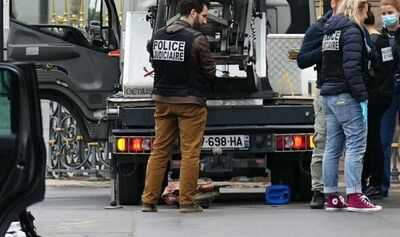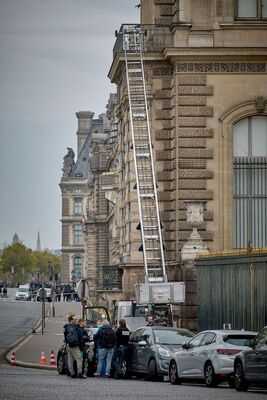
Priceless jewels belonging to Napoleon stolen by "cultural terrorists" in a brazen raid on the Louvre will likely be "lost forever", a world renowned art recovery expert has warned.
The French woke up to the unbelievable news on Sunday that crooks had carried out the unthinkable attack on the nation's most iconic art museum in Paris, breaking their way in with industrial "disc cutters' at around 9.30am.
Authorities said it took the audacious thieves just seven minutes to swipe nine priceless pieces of jewellery that once belonged to Napoleon Bonaparte and his family, with two recovered soon afterwards after apparently being dropped and damaged.
Interior Minister Laurent Nuñez said two thieves arrived on Yamaha Tmax scooters, while two others were waiting on the back of a flat-bed truck with an extendable ladder.
All were dressed as workers, with helmets and hi-viz yellow vests, and they targeted a wing of the Louvre by the Seine River, where construction work was ongoing. They then used the ladder to get up to a window close to the Apollo Gallery (Galerie d'Apollon). A flatbed truck was photographed at the scene on Sunday morning as forensic teams searched the scene. An industrial disc cutter could be seen lying on the road beneath the van.
French Interior Minister Laurent Nuñez was joined at the site by his colleague, the glamorous Culture Minister Rachida Dati. The theft of French cultural treasures from a world famous venue could be seen as an embarrassment for President Emmanuel Macron's beleaguered government.
Christopher A. Marinello, founder ofArt Recovery International, is one of the world's foremost experts in recovering stolen, looted, and missing works of art. He told the Daily Express it was now a race against time for the police as it was likely the "pieces would be broken up and lost forever".

"The criminals are going to try and hide the crime as quickly as possible, and how do they do that? they break up the jewellery, they melt any precious metals, if there are any diamonds or stones of value, they will have them re-cut... they are not interested in keeping these items intact and preserving our cultural heritage."
Mr Marinello said the mindset of thieves targeting museums had changed in recent years, and crooks were increasingly not concerned about the condition of the precious items they were stealing.
"They don't care about cultural heritage, it's all about money with them. Intact (the objects) they can't do anything with it, in the old days they used to keep them intact and wait for an insurance company to come forward, or I would get a call and somebody would say 'I know where these are, is there a reward being offered?', or they would ransom them back to the museum... that's how things used to happen... Now, these gangs that are operating throughout Europe are so hungry for cash that they just throw the cultural importance of the piece out of the window.
"It's all about the raw material, they are ignorant, they just don't care about the history of Napoleon, or anything about these pieces, they are just stones and precious metals to them.
"It's heartbreaking, how do you hide a diamond? you break it up into smaller diamonds, it's still valuable, you can still get money for it, but no one is going to know it came from this particular theft, these diamonds are not marked."
Speaking about the security measures the thieves may have had to negotiate, Mr Marinello added: "The security measures can't get any better than at the Louvre, or the British Museum, or the Metropolitan in New York, these are major museums, so when we talk about security there is no place better.
"But I think we need to start looking in the other direction and cut the motivation of criminals to take on these types of thefts, we need to start treating art theft as an act or terrorism, and start prosecuting thieves as terrorists, cultural heritage terrorists, because that's what they are, they are stealing things from us as people, these museums are supposed to be able to preserve and protect these objects for all of humanity, for all time.
"These thieves are just taking things away, melting them down, breaking up stones, so that they can buy a new car, or whatever the hell it is they do with their money, drugs."

Mr Marinello said law enforcement and governments across the world needed to "start taking this more seriously" and "charging these criminals with more serious crimes" to have an impact.
"There used to be a deterrent factor, making thieves think 'I don't want to break into a museum because I'll go to jail for 10 years', now that's not the case, there is not enough jail space to house these people so they are letting them out early." he said.
"So criminals are thinking, 'what have I got to lose? let me steal from the Louvre, what's the worst that can happen?' They might go to jail for a year, it's worth the risk. We used to say 'crime doesn't pay', well now it does.
Referring to cases in the UK, Mr Marinello highlighted the theft of a golden toilet artwork, named America, from Blenheim Palace in 2019. A gang was convicted earlier this year in relation to the theft of the £4.8m gold convenience from an art exhibition at the stately home. A court heard within days the artwork had been broken up and sold on. None of the gold has been recovered.
In January this year thieves broke into the Drents Museum in the Netherlands and stole ancient gold and silver jewellery from Romania. Among the treasures, worth around £6million, was a unique gold helmet from the Dacian Empire, dating back to 500 BC. None of the items has yet been recovered.
Last month the Egyptian museum in Cairo said a 3,000-year-old gold bracelet had been stolen and melted down. The interior ministry said the priceless item belonged to King Amenemope, a pharaoh who ruled Egypt around 1,000BC
"The golden toilet, they broke that thing up in minutes and melted it down within 24 hours, and then there was the Drents Museum in the Netherlands, where the thieves stole priceless Romanian artefacts made of gold," Mr Marinello continued.
"So museums and exhibitions have been hit outside of London, in the Netherlands, in Egypt, and now in Paris, these gangs are going after precious metals, gold is the highest price it's been."

Looking into whether the thieves could have had help from inside the museum, Mr Marinello said he was somewhat sceptical. He said: "They wouldn't have needed the amount of equipment they brought with them, from what I have read about the electric saws, and the ladders and all that stuff.
"It is quite possible they could have had help, and that's something the French police are going to investigate. But to take on the Louvre is pretty brash, but these guys were carrying small chainsaws, so that just tells me that the value of what they were taking was worth risking getting caught and spending only a short period of time in jail."
Thinking about the thieves using a construction site at the side of the Louvre as cover for the noise of tools, Mr Marinello joked: Nobody works on Sunday in France, let alone part of the week.
"It's like breaking into Fort Knox, the Louvre is a major museum that is not supposed to have this type of theft, so this is very, very brash.
"Once the items are broken down, the market could be anywhere. Kept intact they can't sell these anywhere, they would be traded at a fraction of their true value, maybe 5% of what they are really worth on the chance of some other criminal holding out for a reward or ransom.
"But these criminals have no knowledge or interest in the cultural heritage of these pieces."
You may also like

Russia burning as devastating Ukrainian strike behind enemy lines causes 600ft fireball

GB News host Eamonn Holmes surprises fans with ageless appearance

New retinal implant restores vision in patients with irreversible blindness

Indian Railways Takes Strict Action in Jabalpur “Samosa-Clock” Case: Vendor Detained, License Cancelled

SIT to submit first progress report on Sabarimala gold case to Kerala HC







